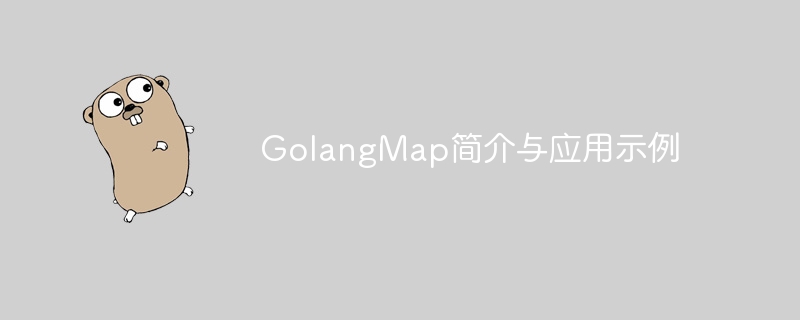

GolangMap Introduction and Application Examples
Golang is a programming language developed by Google and is widely used in web development, cloud computing, embedded systems and other fields. Among them, Map is a data structure in Golang, used to store key-value pairs. This article will introduce the basic usage of GolangMap and its practical application examples.
Basic usage of GolangMap
Golang's Map is an unordered collection of key-value pairs, where the keys and values can be of any type. The declaration and initialization method of Map is as follows:
//声明一个Map var map1 map[string]int //初始化Map map1 = make(map[string]int) //或者声明并初始化Map map2 := make(map[string]int)
Among them, the first example declares an uninitialized Map, and the second example declares and initializes a Map, which can be used as needed. To add a key-value pair in a Map, you can use the following method:
//添加键值对 map1["one"] = 1 map1["two"] = 2 map1["three"] = 3
To access the value corresponding to a key in the Map, you can use the following method:
//访问键对应的值 value := map1["one"]
If you access a non-existent key, it will Returns the zero value of this type. If you need to determine whether the key exists, you can use the following method:
//判断键是否存在 value, ok := map1["four"] if ok { fmt.Println("the value of four is", value) } else { fmt.Println("four does not exist in the map") }
The second return value is of bool type, indicating whether the key exists.
Application examples of GolangMap
In practical applications, GolangMap can be used to solve many problems. Several examples will be introduced below.
Suppose we now need to count the number of times each word appears in an article. We can use Map to achieve this:
package main import ( "fmt" "strings" ) func main() { text := "A happy family is but an earlier heaven." words := strings.Fields(text) wordCount := make(map[string]int) for _, word := range words { wordCount[word]++ } for word, count := range wordCount { fmt.Printf("%s:%d ", word, count) } }
Among them, strings.Fields(text) can split the text into a word list, then traverse the word list, count the number of occurrences of each word, and finally output each word and its number of occurrences.
Suppose we need to implement a cache system that can store some objects in memory to improve program performance. We can use Map to achieve:
package main import ( "fmt" "sync" "time" ) type Cache struct { sync.RWMutex data map[string]interface{} } func NewCache() *Cache { return &Cache{data: make(map[string]interface{})} } func (c *Cache) Get(key string) (interface{}, bool) { c.RLock() defer c.RUnlock() val, ok := c.data[key] return val, ok } func (c *Cache) Set(key string, value interface{}) { c.Lock() defer c.Unlock() c.data[key] = value } func main() { cache := NewCache() cache.Set("key1", "value1") cache.Set("key2", "value2") fmt.Println(cache.Get("key1")) fmt.Println(cache.Get("key2")) time.Sleep(time.Second * 2) fmt.Println(cache.Get("key1")) cache.Set("key2", "new value2") fmt.Println(cache.Get("key2")) }
Among them, the NewCache() function is used to initialize an empty Cache object, the Get() function is used to obtain the value corresponding to a certain key, and the Set() function is used to add Or modify the value corresponding to a key. In the main() function, we first add two key-value pairs, then output their values, and then wait for 2 seconds and output the value of one of the keys again. You can see that the cache has not expired, and then modified the corresponding key value, and finally output the value of the key.
Suppose we need to implement a message queue, which can store some messages in memory to achieve asynchronous processing. We can use Map to achieve:
package main import ( "fmt" "sync" ) type MessageQueue struct { sync.Mutex data map[int]string index int } func NewMessageQueue() *MessageQueue { return &MessageQueue{data: make(map[int]string)} } func (mq *MessageQueue) Enqueue(msg string) { mq.Lock() defer mq.Unlock() mq.index++ mq.data[mq.index] = msg } func (mq *MessageQueue) Dequeue() string { mq.Lock() defer mq.Unlock() msg, ok := mq.data[1] if !ok { return "" } delete(mq.data, 1) for i := 2; i <= mq.index; i++ { mq.data[i-1] = mq.data[i] } mq.index-- return msg } func main() { mq := NewMessageQueue() mq.Enqueue("hello") mq.Enqueue("world") mq.Enqueue("golang") fmt.Println(mq.Dequeue()) fmt.Println(mq.Dequeue()) fmt.Println(mq.Dequeue()) fmt.Println(mq.Dequeue()) }
Among them, the NewMessageQueue() function is used to initialize an empty MessageQueue object, the Enqueue() function is used to add a message to the message queue, and the Dequeue() function is used to obtain A message in the message queue. In the main() function, we first add 3 messages to the message queue, then output them in sequence, and finally output a non-existent message.
Summary
GolangMap is a data structure in Golang that can be used to store key-value pairs. In practical applications, GolangMap can be used to solve many practical problems, such as counting the number of word occurrences, implementing caching, implementing message queues, etc. This article introduces the basic usage of GolangMap and several practical application examples. I hope it will be helpful to Golang learners.
The above is the detailed content of Understand and apply examples of GolangMap. For more information, please follow other related articles on the PHP Chinese website!
 How to define variables in golang
How to define variables in golang What are the data conversion methods in golang?
What are the data conversion methods in golang? What are the commonly used libraries in golang?
What are the commonly used libraries in golang? What is the difference between golang and python
What is the difference between golang and python There are several types of browser kernels
There are several types of browser kernels How to withdraw cash from Yiouokex
How to withdraw cash from Yiouokex What is the difference between blocking and deleting on WeChat?
What is the difference between blocking and deleting on WeChat? no such file solution
no such file solution



